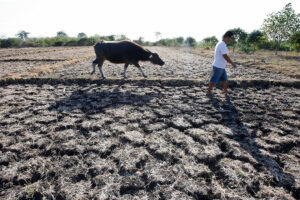A LOOMING El Niño dry spell is expected to reduce rice production in Southeast Asia, raising the prospect of higher food prices, the World Bank said.
“The rapid emergence of El Niño has raised concerns about possible impacts on rice production in South and Southeast Asia, which could trigger further price increases that could hurt consumers in the regions,” it said in its latest Food Security Update report.
The government weather service, known as PAGASA (Philippine Atmospheric, Geophysical and Astronomical Services Administration), expects the El Niño event to run until the first quarter of 2024.
According to PAGASA, El Niño increases the likelihood of below-normal rainfall, which could bring dry spells and droughts in parts of the country.
The last time an El Niño hit the Philippines was in 2019, which led to agricultural damage of up to P8 billion.
“During the past year, since Russia invaded Ukraine, agricultural markets have seen significant volatility as impacts from the war, combined with tight global stocks, have driven prices to record nominal highs,” the report said.
In the coming months, global rice markets could be impacted by the looming El Niño, low fertilizer availability and restrictive trade policies, the World Bank said, citing the International Food Policy Research Institute.
South Asian and Southeast Asian countries account for almost 60% of global rice production and more than 80% of global rice exports, the report said.
“An upcoming El Niño and a positive Indian Ocean dipole potentially resulting in warm, dry weather could affect rice production,” it added.
The National Oceanic and Atmospheric Administration said there is an 82% chance of an El Niño developing during May to July 2023 and an 89% chance in June to August.
“A strong El Niño developing this summer could have a significant impact during the monsoon season,” it added.
The study showed that rice yields dropped 4% to 11% due to low rainfall in previous El Niño episodes since 2000.
“A 2023 study shows that El Niño will reduce the global mean rice yield by 1.3% and significantly harm 13.4% of rice harvest areas, with Bangladesh, India, Indonesia, and Vietnam the most affected,” it added.
Fertilizer availability is also expected to affect rice production, according to the report.
“Rice yields in Asia have been generally at or above year-ago levels, but if shortages of fertilizer components persist into the new crop year, yields could be affected,” it added.
Trade restrictions may also cause rice prices to spike.
“As evidenced in 2022, there is a positive association between food prices and share of restricted global food trade,” the report said.
An estimated 5.5 percentage point increase in food inflation could lead to a higher likelihood of a country imposing export restriction on commodities. — Luisa Maria Jacinta C. Jocson
